标签:自动 分割 上下文 有用 手册 imp 正则表达 dev 过程
这篇文章主要来介绍下什么是 Analysis ,什么是分词器,以及 ElasticSearch 自带的分词器是怎么工作的,最后会介绍下中文分词是怎么做的。首先来说下什么是 Analysis:
顾名思义,文本分析就是把全文本转换成一系列单词(term/token)的过程,也叫分词。在 ES 中,Analysis 是通过分词器(Analyzer) 来实现的,可使用 ES 内置的分析器或者按需定制化分析器。
举一个分词简单的例子:比如你输入 Mastering Elasticsearch,会自动帮你分成两个单词,一个是 mastering,另一个是 elasticsearch,可以看出单词也被转化成了小写的。

再简单了解了 Analysis 与 Analyzer 之后,让我们来看下分词器的组成:
分词器是专门处理分词的组件,分词器由以下三部分组成:
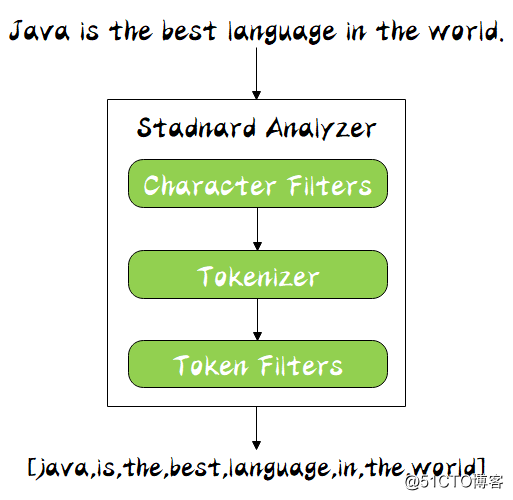
分词器的组成
同时 Analyzer 三个部分也是有顺序的,从图中可以看出,从上到下依次经过 Character Filters,Tokenizer 以及 Token Filters,这个顺序比较好理解,一个文本进来肯定要先对文本数据进行处理,再去分词,最后对分词的结果进行过滤。
其中,ES 内置了许多分词器:
接下来会对以上分词器进行讲解,在讲解之前先来看下很有用的 API:_analyzer API:
它可以通过以下三种方式来查看分词器是怎么样工作的:
直接指定 Analyzer 进行测试
GET _analyze
{
"analyzer": "standard",
"text" : "Mastering Elasticsearch , elasticsearch in Action"
}指定索引的字段进行测试
POST books/_analyze
{
"field": "title",
"text": "Mastering Elasticesearch"
}自定义分词进行测试
POST /_analyze
{
"tokenizer": "standard",
"filter": ["lowercase"],
"text": "Mastering Elasticesearch"
}再了解了 Analyzer API 后,让我们一起看下 ES 内置的分词器:
ES 分词器
首先来介绍下 Stamdard Analyzer 分词器:

Stamdard Analyzer
它是 ES 默认的分词器,它会对输入的文本按词的方式进行切分,切分好以后会进行转小写处理,默认的 stopwords 是关闭的。
下面使用 Kibana 看一下它是怎么样进行工作的,在 Kibana 的开发工具(Dev Tools)中指定 Analyzer 为 standard,并输入文本 In 2020, Java is the best language in the world.,然后我们运行一下:
GET _analyze
{
"analyzer": "standard",
"text": "In 2020, Java is the best language in the world."
}运行结果如下:
{
"tokens" : [
{
"token" : "in",
"start_offset" : 0,
"end_offset" : 2,
"type" : "<ALPHANUM>",
"position" : 0
},
{
"token" : "2020",
"start_offset" : 3,
"end_offset" : 7,
"type" : "<NUM>",
"position" : 1
},
{
"token" : "java",
"start_offset" : 9,
"end_offset" : 13,
"type" : "<ALPHANUM>",
"position" : 2
},
{
"token" : "is",
"start_offset" : 14,
"end_offset" : 16,
"type" : "<ALPHANUM>",
"position" : 3
},
{
"token" : "the",
"start_offset" : 17,
"end_offset" : 20,
"type" : "<ALPHANUM>",
"position" : 4
},
{
"token" : "best",
"start_offset" : 21,
"end_offset" : 25,
"type" : "<ALPHANUM>",
"position" : 5
},
{
"token" : "language",
"start_offset" : 26,
"end_offset" : 34,
"type" : "<ALPHANUM>",
"position" : 6
},
{
"token" : "in",
"start_offset" : 35,
"end_offset" : 37,
"type" : "<ALPHANUM>",
"position" : 7
},
{
"token" : "the",
"start_offset" : 38,
"end_offset" : 41,
"type" : "<ALPHANUM>",
"position" : 8
},
{
"token" : "world",
"start_offset" : 42,
"end_offset" : 47,
"type" : "<ALPHANUM>",
"position" : 9
}
]
}可以看出是按照空格、非字母的方式对输入的文本进行了转换,比如对 Java 做了转小写,对一些停用词也没有去掉,比如 in。
其中 token 为分词结果;start_offset 为起始偏移;end_offset 为结束偏移;position 为分词位置。
下面来看下 Simple Analyzer 分词器:
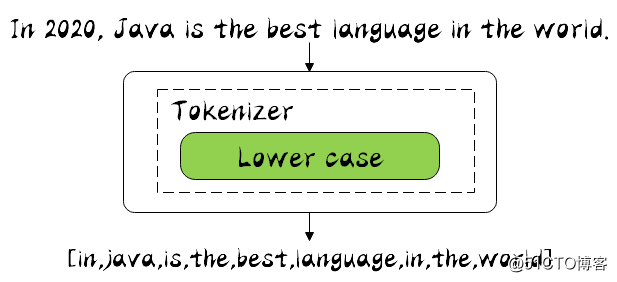
Simple Analyzer
它只包括了 Lower Case 的 Tokenizer,它会按照非字母切分,非字母的会被去除,最后对切分好的做转小写处理,然后接着用刚才的输入文本,分词器换成 simple 来进行分词,运行结果如下:
{
"tokens" : [
{
"token" : "in",
"start_offset" : 0,
"end_offset" : 2,
"type" : "word",
"position" : 0
},
{
"token" : "java",
"start_offset" : 9,
"end_offset" : 13,
"type" : "word",
"position" : 1
},
{
"token" : "is",
"start_offset" : 14,
"end_offset" : 16,
"type" : "word",
"position" : 2
},
{
"token" : "the",
"start_offset" : 17,
"end_offset" : 20,
"type" : "word",
"position" : 3
},
{
"token" : "best",
"start_offset" : 21,
"end_offset" : 25,
"type" : "word",
"position" : 4
},
{
"token" : "language",
"start_offset" : 26,
"end_offset" : 34,
"type" : "word",
"position" : 5
},
{
"token" : "in",
"start_offset" : 35,
"end_offset" : 37,
"type" : "word",
"position" : 6
},
{
"token" : "the",
"start_offset" : 38,
"end_offset" : 41,
"type" : "word",
"position" : 7
},
{
"token" : "world",
"start_offset" : 42,
"end_offset" : 47,
"type" : "word",
"position" : 8
}
]
}从结果中可以看出,数字 2020 被去除掉了,说明非字母的的确会被去除,所有的词也都做了小写转换。
现在,我们来看下 Whitespace Analyzer 分词器:
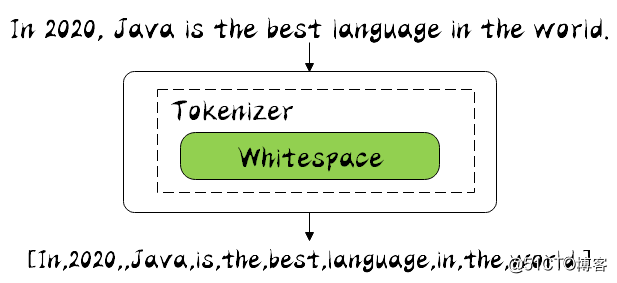
Whitespace Analyzer
它非常简单,根据名称也可以看出是按照空格进行切分的,下面我们来看下它是怎么样工作的:
{
"tokens" : [
{
"token" : "In",
"start_offset" : 0,
"end_offset" : 2,
"type" : "word",
"position" : 0
},
{
"token" : "2020,",
"start_offset" : 3,
"end_offset" : 8,
"type" : "word",
"position" : 1
},
{
"token" : "Java",
"start_offset" : 9,
"end_offset" : 13,
"type" : "word",
"position" : 2
},
{
"token" : "is",
"start_offset" : 14,
"end_offset" : 16,
"type" : "word",
"position" : 3
},
{
"token" : "the",
"start_offset" : 17,
"end_offset" : 20,
"type" : "word",
"position" : 4
},
{
"token" : "best",
"start_offset" : 21,
"end_offset" : 25,
"type" : "word",
"position" : 5
},
{
"token" : "language",
"start_offset" : 26,
"end_offset" : 34,
"type" : "word",
"position" : 6
},
{
"token" : "in",
"start_offset" : 35,
"end_offset" : 37,
"type" : "word",
"position" : 7
},
{
"token" : "the",
"start_offset" : 38,
"end_offset" : 41,
"type" : "word",
"position" : 8
},
{
"token" : "world.",
"start_offset" : 42,
"end_offset" : 48,
"type" : "word",
"position" : 9
}
]
}可以看出,只是按照空格进行切分,2020 数字还是在的,Java 的首字母还是大写的,, 还是保留的。
接下来看 Stop Analyzer 分词器:
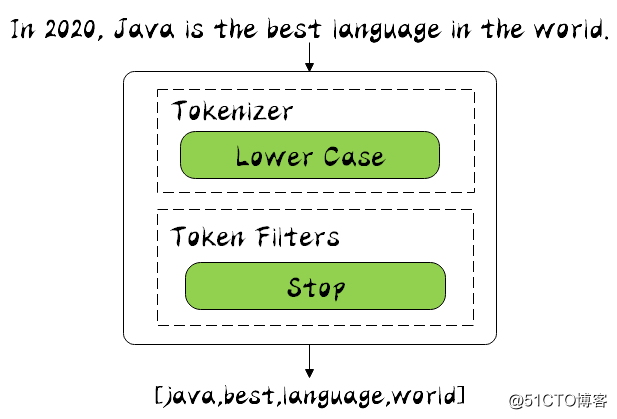
Stop Analyzer
它由 Lowe Case 的 Tokenizer 和 Stop 的 Token Filters 组成的,相较于刚才提到的 Simple Analyzer,多了 stop 过滤,stop 就是会把 the,a,is 等修饰词去除,同样让我们看下运行结果:
{
"tokens" : [
{
"token" : "java",
"start_offset" : 9,
"end_offset" : 13,
"type" : "word",
"position" : 1
},
{
"token" : "best",
"start_offset" : 21,
"end_offset" : 25,
"type" : "word",
"position" : 4
},
{
"token" : "language",
"start_offset" : 26,
"end_offset" : 34,
"type" : "word",
"position" : 5
},
{
"token" : "world",
"start_offset" : 42,
"end_offset" : 47,
"type" : "word",
"position" : 8
}
]
}可以看到 in is the 等词都被 stop filter过滤掉了。
接下来看下 Keyword Analyzer:
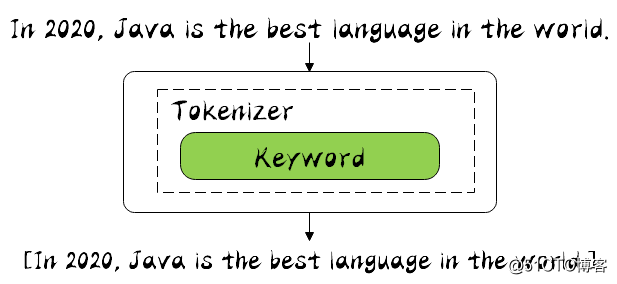
Keyword Analyzer
它其实不做分词处理,只是将输入作为 Term 输出,我们来看下运行结果:
{
"tokens" : [
{
"token" : "In 2020, Java is the best language in the world.",
"start_offset" : 0,
"end_offset" : 48,
"type" : "word",
"position" : 0
}
]
}我们可以看到,没有对输入文本进行分词,而是直接作为 Term 输出了。
接下来看下 Pattern Analyzer:
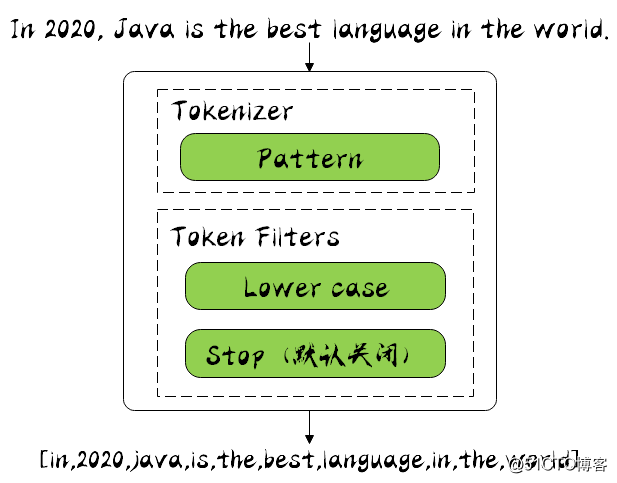
Pattern Analyzer
它可以通过正则表达式的方式进行分词,默认是用 \W+ 进行分割的,也就是非字母的符合进行切分的,由于运行结果和 Stamdard Analyzer 一样,就不展示了。
ES 为不同国家语言的输入提供了 Language Analyzer 分词器,在里面可以指定不同的语言,我们用 english 进行分词看下:
{
"tokens" : [
{
"token" : "2020",
"start_offset" : 3,
"end_offset" : 7,
"type" : "<NUM>",
"position" : 1
},
{
"token" : "java",
"start_offset" : 9,
"end_offset" : 13,
"type" : "<ALPHANUM>",
"position" : 2
},
{
"token" : "best",
"start_offset" : 21,
"end_offset" : 25,
"type" : "<ALPHANUM>",
"position" : 5
},
{
"token" : "languag",
"start_offset" : 26,
"end_offset" : 34,
"type" : "<ALPHANUM>",
"position" : 6
},
{
"token" : "world",
"start_offset" : 42,
"end_offset" : 47,
"type" : "<ALPHANUM>",
"position" : 9
}
]
}可以看出 language 被改成了 languag,同时它也是有 stop 过滤器的,比如 in,is 等词也被去除了。
最后,让我们看下中文分词:
中文分词有特定的难点,不像英文,单词有自然的空格作为分隔,在中文句子中,不能简单地切分成一个个的字,而是需要分成有含义的词,但是在不同的上下文,是有不同的理解的。
比如以下例子:
在这些,企业中,国有,企业,有十个/在这些,企业,中国,有企业,有十个
各国,有,企业,相继,倒闭/各,国有,企业,相继,倒闭
羽毛球,拍卖,完了/羽毛球拍,卖,完了那么,让我们来看下 ICU Analyzer 分词器,它提供了 Unicode 的支持,更好的支持亚洲语言!
我们先用 standard 来分词,以便于和 ICU 进行对比。
GET _analyze
{
"analyzer": "standard",
"text": "各国有企业相继倒闭"
}运行结果就不展示了,分词是一个字一个字切分的,明显效果不是很好,接下来用 ICU 进行分词,分词结果如下:
{
"tokens" : [
{
"token" : "各国",
"start_offset" : 0,
"end_offset" : 2,
"type" : "<IDEOGRAPHIC>",
"position" : 0
},
{
"token" : "有",
"start_offset" : 2,
"end_offset" : 3,
"type" : "<IDEOGRAPHIC>",
"position" : 1
},
{
"token" : "企业",
"start_offset" : 3,
"end_offset" : 5,
"type" : "<IDEOGRAPHIC>",
"position" : 2
},
{
"token" : "相继",
"start_offset" : 5,
"end_offset" : 7,
"type" : "<IDEOGRAPHIC>",
"position" : 3
},
{
"token" : "倒闭",
"start_offset" : 7,
"end_offset" : 9,
"type" : "<IDEOGRAPHIC>",
"position" : 4
}
]
}可以看到分成了各国,有,企业,相继,倒闭,显然比刚才的效果好了很多。
还有许多中文分词器,在这里列举几个:
大家可以自己安装下,看下它中文分词效果。
本文主要介绍了 ElasticSearch 自带的分词器,学习了使用 _analyzer API 去查看它的分词情况,最后还介绍下中文分词是怎么做的。
参考文献
Elasticsearch顶尖高手系列
Elasticsearch核心技术与实战
https://www.elastic.co/guide/en/elasticsearch/reference/7.1/indices-analyze.html
https://www.elastic.co/guide/en/elasticsearch/reference/current/analyzer-anatomy.html
完
●深入源码分析SpringMVC执行过程
●为什么阿里巴巴Java开发手册中不建议在循环体中使用+进行字符串拼接?
●为什么阿里巴巴Java开发手册中强制要求整型包装类对象值用 equals 方法比较?

武培轩
有帮助?在看,转发走一波
喜欢作者
标签:自动 分割 上下文 有用 手册 imp 正则表达 dev 过程
原文地址:https://blog.51cto.com/14901336/2522707